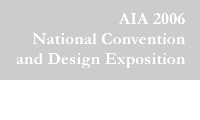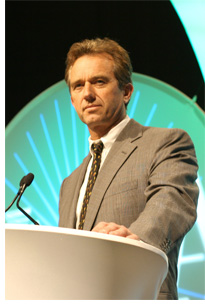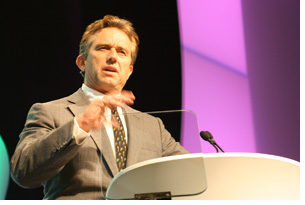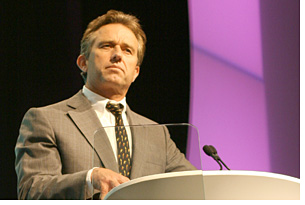

6/2006
Robert Kennedy Jr. urges greener material, design with nature

 Robert F. Kennedy Jr. is a lifelong environmentalist. As a young boy, he bred homing pigeons and pheasants in his backyard and learned to train hawks. Today, Kennedy is widely recognized as the country's most prominent environmental attorney, working tirelessly to safeguard the environment. Kennedy addressed his environmental concerns to AIA attendees on Thursday, June 8 in his session, “A Contract with Our Future.”
Robert F. Kennedy Jr. is a lifelong environmentalist. As a young boy, he bred homing pigeons and pheasants in his backyard and learned to train hawks. Today, Kennedy is widely recognized as the country's most prominent environmental attorney, working tirelessly to safeguard the environment. Kennedy addressed his environmental concerns to AIA attendees on Thursday, June 8 in his session, “A Contract with Our Future.”
Kennedy’s environmental experience is extensive. He currently serves as senior attorney for the New-York based Natural Resources Defense Council, which specializes in green issues and “fights for those who can't.” As chief prosecuting attorney for Riverkeeper, a Tarrytown, N.Y.-based advocacy group that monitors the Hudson River ecosystem, he prosecutes "Pollution" polluters and, in 1997, negotiated the New York City Watershed Agreement with the Environmental Protection Agency. As a result, Kennedy was named one of Time magazine's “Heroes for the Planet.” He is also president of The Waterkeeper Alliance, the Irvington, New York-based international network of 153 “Waterkeeper” groups worldwide that are part watershed investigators, scientists, lawyers, and advocates. Kennedy is also the founder, director, and supervising attorney of Pace University's Environmental Litigation Clinic in White Plains, New York, and co-host of Ring of Fire on Air America Radio. Kennedy has negotiated environmental treaties in various countries, and is credited with turning back anti-environmental legislation during the 104th Congress.
 In his address, Kennedy urged attendees to be cognizant of the impact of construction materials on the environment. “Forty-eight percent of greenhouse gases come from structures,” he stated. “The materials we use when designing and constructing buildings can dramatically increase or decrease the way we live. Greener materials will reduce global warming and increase our prosperity, health, and welfare.”
In his address, Kennedy urged attendees to be cognizant of the impact of construction materials on the environment. “Forty-eight percent of greenhouse gases come from structures,” he stated. “The materials we use when designing and constructing buildings can dramatically increase or decrease the way we live. Greener materials will reduce global warming and increase our prosperity, health, and welfare.”
Kennedy told the audience his definition of sustainability. “Sustainability means that God wants us to use the things that we were given to prosper.” But he expressed his concerns that corporate big business is interfering with our ability to take advantages of our natural resources. “We are living in a science fiction nightmare. Corporations are paying off our government to pollute our environment. There is nothing wrong with corporations, but they should not be running our government. Pollution is the result of the subsidizing of fat cats . . . just a result of shifting clean-up costs and stealing public trust assets. As a result, for example, coal burning power plants are putting ozone particles into the atmosphere illegally, causing bad air and polluted water. I don’t want children gasping for air on bad-air days or unable to engage in the primal activity of fishing with their parents just because someone donated money to a politician.”
 Kennedy maintained that when we destroy nature, we diminish ourselves, urging architects to immerse themselves in their creativity but combine it with nature. “America is about nature. For generations we were not cutting down trees; we were connecting with nature and creativity though art, literature, poetry, music, and architecture.”
Kennedy maintained that when we destroy nature, we diminish ourselves, urging architects to immerse themselves in their creativity but combine it with nature. “America is about nature. For generations we were not cutting down trees; we were connecting with nature and creativity though art, literature, poetry, music, and architecture.”
It is important, according to Kennedy, that we remember why we need to be responsible about sustainability. “Protecting the environment is not for the sake of the fish and the birds; it is to protect the air we breathe, the water we drink, and our economic infrastructure. It is to provide context to our communities through aesthetics and spirituality. But we cannot treat the planet like it is business liquidation because although our economy would prosper in the short-term, our children would pay for our joyride. We must be a boulevard to future generations.”
Copyright 2006 The American Institute of Architects.
All rights reserved. Home Page ![]()
![]()
Photos by Aaron Johnson,
Innov8iv Design Incorporated.
![]()